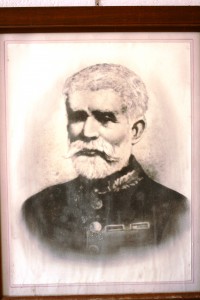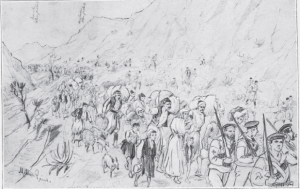Here is what became known as “The Battle of Paleochora”.
Speaking in the House of Commons on 10th March 1897, George Curzon, Under Secretary of State for Foreign Affairs, reported that a telegram had been received from Sir Alfred Biliotti, the British Consul in Canea which read: “Successfully rescued to-day, but not without the greatest peril, 523 men, 1,047 women and children, and 340 soldiers from Candamos. Picked (up) on way back 112 soldiers from Spaniako blockhouse. Natives of Candamos embarked. We are now embarking Mussulman refugees at Selino Castelli, about 1,000. Danger of Christians attacking Selino Castelli.”
The expedition to rescue the Cretan Muslims from Kandanos in 1897 had become necessary when the village, at the time the largest centre of Muslim population in Selinos, came under siege from Cretan Christian irregulars responding to the arrival in Crete of Greek troops under the command of Colonel T. Vassos. A few weeks earlier over 100 Muslim refugees attempting to reach Paleochora from Sarakina had been ambushed and massacred and the fear was that if Kandanos fell, a similar fate would befall its inhabitants and the Ottoman garrison stationed there.
Biliotti arrived in Paleochora on 5 March aboard HMS Rodney, one of the ships in a mixed European force sent to evacuate Kandanos. The following day a landing party consisting of 200 British sailors and marines, with two guns, 100 French with one gun, 100 Austrians troops, 75 Russians and one gun and 50 Italian seamen came ashore and, Biliotti having got agreement for the evacuation from the local Cretan Christian chiefs at a series of meetings held in Beilitika, the force made its way up from Paleochora to Kandanos. They stopped overnight in Spaniakos where a reporter from the Times, R.A.H.Bickford-Smith, who had been travelling with the Cretan Christian insurgents recorded that the French Officers commandeered the mosque while the British had to make do with a small harem. On 7th March the expedition reached Kandanos without serious incident although Biliotti himself had been fired on the previous day when he arrived there to organise the evacuation. The European column escorted the Muslims back down to Paleochora, collecting the garrison of the fort at Spaniakos as well, and in spite of the refugees being robbed of nearly all their possessions en route, managed to effect the evacuation without bloodshed.
However, on arrival at Paleochora that evening, the Christian Cretan insurgents opened fire and appeared to be about to attempt to storm village. They were eventually driven off by fire from the Russian field gun though they continued to lay siege to two small Ottoman redoubts just outside the village; one of the redoubts was evacuated during the night but the one on the eastern hill above Paleochora remained occupied, the troops being unable to retreat. The following morning the Christians again opened fire on the troops on the beach and this time fire was returned by the European troops and the warships in the bay. As a result, the bulk of the Christian fighters withdrew and then, in order to relieve the 30 Ottoman troops still under siege in the remaining redoubt, the European forces advanced up the hill with fixed bayonets. The bayonet charge was successful; apparently the European troops did not need to open fire since the besiegers withdrew when rocks and stones were thrown at them. No Europeans were injured in the whole exercise but four insurgents were killed and sixteen wounded. When the fighting had ceased, Bickford Smith recorded that a Christian chief came under a flag of truce to express his, and the other chiefs’, regrets that the international force had been fired on; this was the work of people of the worst type who were quite out of control and he said hoped that the international force should fire on them if they tried to advance again. (Biliotti in his report, does not record if this was the same chief who, pointing out that the Christians were no longer fighting Muslims, asked for the Europeans to give him 300 bags of flour; a request that was denied.)
The evacuation continued without further incident although complications did arise over the fate of a pregnant Muslim woman who had to be left behind in Kandanos – her husband’s father had once saved the life of a Christian chief and so the chief’s son took responsibility for her safety – and over two Muslim women who were said to want to embrace Christianity in order to marry two young Christian men.
The Muslim retreat from Kandanos and the subsequent evacuation signalled the effective end of a Muslim presence in Selinos, an event commemorated by a monument in the grounds of the school at Beilitika, above Kakodiki, the translation of which reads:
“At Beilitika, Kakodiki, in 1897, the treaty of surrender of the Turks of Selino who were surrounded in Kandanos was signed and we were freed after 3 centuries of slavery.”
A footnote to the 1897 events at Paleochora appeared in the British Medical Journal of 8th May that year. Staff-Surgeon E.J.Biden, a Doctor on HMS Scout, one of the warships present at Paleochora during the Kandanos evacuation, published an article detailing the effects on the human body produced by a 5-inch shrapnel shell mark III fired at a range of 2,500 yards; the victim being one of Cretan fighters who had attacked the international force. The good Doctor regretted that his ship had been ordered to sea before he was able to visit the other Cretan injured and thus he was denied the opportunity to make further observations on the effects of British shrapnel shells.
Footnote: Mick & Barry have scouted round the areas where the two Ottoman redoubts once stood. They were on opposite hilltops adjacent to the road and river entering Paleochora. Although nothing remains of the one on the east side, the remains of the western redoubt are still clearly visible. It is an easy (although often quite steep) walk up to the radio transmitter masts on the hill behind the town. The redoubt is situated just beyond the single (Vodafone) mast overlooking the river valley. A video will be produced showing this and posted on here.




Recent Comments